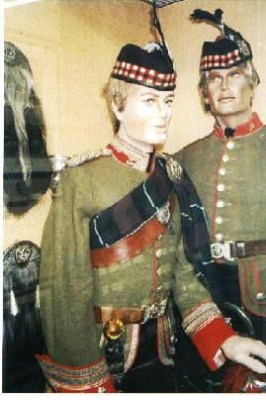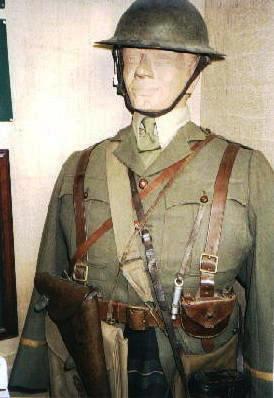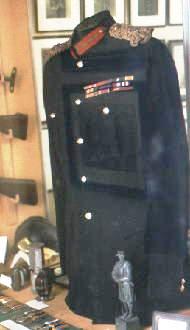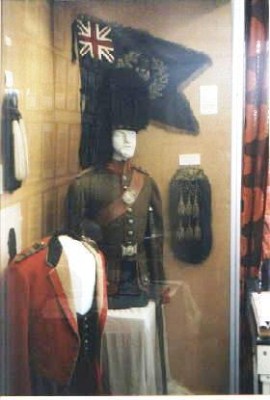Display of Uniforms
 Highland Full Dress Uniform circa 1900.
Highland Full Dress Uniform circa 1900.
On the left of the picture is the uniform of Colonel Forbes Bell VD (Volunteer Decoration) and on the right is a private soldier also of the period immediately after 1900. Silver lace (on the scarlet collar and cuffs) and silver shoulder cords are seen, indicating the volunteer status of the unit; officers of the regular Army would have had gold cords and lace. Colonel Forbes Bell's field rank (major, lieutenant colonel or colonel) is indicated not only by badges of rank on the shoulder cords but also by the lace rings on his cuffs. Head dress is a glengarry with a blackcock plume. Feather bonnets were also worn on occasion. The amber object seen to be worn at the right hip is a cairngorm(a semi-pre ious stone) which forms the pommel of his dirk (a large hunting knife with a blade etched with the decorative motifs and the regimental title of the Liverpool Scottish). The scabbard of the dirk houses a small knife and fork in separate compartments. His left hand rests on the nickel-plated basket hilt of his broadsword, the blades of many of which were finely etched with regimental titles and decorative foliage. In some regiments the blades would be etched with the name of the officer for whom the weapon was made. On the left two Liverpool Scottish goathair sporrans with silver cantle (top) and two silver bells with black tassels can be seen.
Service Dress circa 1916.
 This is the standard uniform of a subaltern officer (a lieutenant or second lieutenant); he would have bought his own uniform which would be tailored for him. The rings of braid on the cuffs denoting rank can just be seen and one or two rank stars (known colloquially as 'pips') would also be worn on the cuffs. The pockets, secured with leather-covered buttons, were generally 'bellows pockets' cut with a fold in the cloth to allow for expansion as they filled up with the thousand and one bits and pieces any soldier or officer would carry for comfort or survival. The equipment belt is made of leather and is not the standard Sam Browne belt with a single cross-strap. From this belt would be suspended a revolver holster and amongst other impedimenta perhaps a map case, a compass case and a respirator (gas mask) . Gas had been used early in 1915 by the Germans against the French and the Canadians. A whistle hangs from his left breast pocket. Steel helmets did not become general until 1916 and, at the outset of the Great War, the Liverpool Scottish (together with many other kilted regiments) had worn the glengarry which was replaced gradually amongst the soldiers by the khaki 'balmoral' or 'Tam o'Shanter' (TOS), a change which was complete by early 1916. This officer and his men would have worn a kilt of the Forbes tartan, the only concession on the front line being that it may have been covered by a kilt apron of khaki or brown cloth worn over the front of the kilt. In wet and cold weather the edge of the kilt could freeze and would have a cutting action against the legs. On the feet, soldiers wore boots with puttees (wrap-round cloth strips that secured the top of the boot and gave protection to the leg). When the Liverpool Scottish first moved to France in 1914, soldiers were wearing civilian shoes with gaiters (spats) which proved no defence against mud and water. Boots and puttees did not become available until 1915. The medical officer, Noel Chavasse, fought a long battle against the effects of Trench Foot amongst the soldiers and developed strategies such as rubbing feet with spirits (though the use of their rum ration for this purpose was not popular) and ensuring that there were plenty of changes of socks. It was some time before the preventative measures he used became standard practice throughout the Army.
This is the standard uniform of a subaltern officer (a lieutenant or second lieutenant); he would have bought his own uniform which would be tailored for him. The rings of braid on the cuffs denoting rank can just be seen and one or two rank stars (known colloquially as 'pips') would also be worn on the cuffs. The pockets, secured with leather-covered buttons, were generally 'bellows pockets' cut with a fold in the cloth to allow for expansion as they filled up with the thousand and one bits and pieces any soldier or officer would carry for comfort or survival. The equipment belt is made of leather and is not the standard Sam Browne belt with a single cross-strap. From this belt would be suspended a revolver holster and amongst other impedimenta perhaps a map case, a compass case and a respirator (gas mask) . Gas had been used early in 1915 by the Germans against the French and the Canadians. A whistle hangs from his left breast pocket. Steel helmets did not become general until 1916 and, at the outset of the Great War, the Liverpool Scottish (together with many other kilted regiments) had worn the glengarry which was replaced gradually amongst the soldiers by the khaki 'balmoral' or 'Tam o'Shanter' (TOS), a change which was complete by early 1916. This officer and his men would have worn a kilt of the Forbes tartan, the only concession on the front line being that it may have been covered by a kilt apron of khaki or brown cloth worn over the front of the kilt. In wet and cold weather the edge of the kilt could freeze and would have a cutting action against the legs. On the feet, soldiers wore boots with puttees (wrap-round cloth strips that secured the top of the boot and gave protection to the leg). When the Liverpool Scottish first moved to France in 1914, soldiers were wearing civilian shoes with gaiters (spats) which proved no defence against mud and water. Boots and puttees did not become available until 1915. The medical officer, Noel Chavasse, fought a long battle against the effects of Trench Foot amongst the soldiers and developed strategies such as rubbing feet with spirits (though the use of their rum ration for this purpose was not popular) and ensuring that there were plenty of changes of socks. It was some time before the preventative measures he used became standard practice throughout the Army.
 No1 Dress Uniform of Lt. General Sir Colin Barber.
No1 Dress Uniform of Lt. General Sir Colin Barber.
This is the No.1 dress tunic of Lt. General Sir Colin Barber who had served with the Liverpool Scottish as a young officer and then joined the Queen's Own Cameron Highlanders. Later he was Honorary Colonel of the Liverpool Scottish. It is not a highland pattern but that used by general officers. This would have been worn on ceremonial occasions such a the inspection of troops or formal civic events. It would be combined with 'overall' trousers, 'george' boots and spurs. A sword (of a curved scimitar pattern used by general officers) would have been carried and a ceremonial scarlet sash would around the waist. The red gorget patches with a line of gold braid down the centre on the stand-up collar indicate his senior rank; the gorget patch is reputed to be a vestige of armour in that it represents the suspension point of a small crescent-shaped gilt metal badge (the gorget) which hung round the throat of an officer on duty in the period at the end of the eighteenth century. The gold shoulder cords bear his badges of rank. The shoulder cords have a left and right version (the sword should point forwards and the crossed sword and baton (which a badge of rank common to all general officers in combination with crowns and stars) also have a left and right version. General Barber was a very tall officer and this is reflected in the depth of the tunic.
The Uniform of Captain RFB Dickinson and a Pipe Banner of the Queen's Own Cameron Highlanders
 This case contains the full dress tunic of Captain RFB Dickinson with feather bonnet. Captain Dickinson was killed in the charge at Hooge in June 1915, leading X Company, and was one of three brothers who served in The Liverpool Scottish during the Great War of whom only one survived. By the left arm of the uniform (the viewer's right) can be seen the broadsword with a cross-hilt rather than a basket hilt. The cross-hilt was fitted for active service, replacing the larger basket hilt which was ill-matched for wear with the Sam Browne belt from which it would be suspended by a sword 'frog'. The uniform in the foreground is an officer's scarlet mess kit jacket of The Queen's Own Cameron Highlanders with gold rank shoulder cords. The pattern used by officers of the Liverpool Scottish is similar except that it has black shawl collar edged with white piping. Behind the head of the model is a blue silk pipe banner. This would be suspended from the largest drone of a set of pipes and carried on ceremonial occasions or when pipes are played in the messes. In this case the reverse side is showing although for this pattern of banner both sides are identical. The pattern is that of the79th Cameron Highlanders which from 1841 to 1873 used in green silk but thereafter, having become a Royal regiment, the green silk was replaced with blue. The pattern continued being used by the 1st Battalion, The Queen's Own Cameron Highlanders until amalgamation with the Seaforths in 1961. The centre is embroidered with wreath of thistles and the number LXXIX. Officers' personal arms, crests or monograms were not used on these banners. The 2nd Battalion of The Queen's Own Cameron Highlanders, raised in 1897, carried similar blue fish-tailed banners with a central design similar to that at the centre of a Cameron regimental Colour but with the Union flag appearing only on the obverse side. The banners of the 2nd Battalion were personal to officers and carried their crest, monogram or company letter embroidered on the reverse.The Liverpool Scottish set of pipe banners, an example of which is illustrated elsewhere, was presented by individuals at the time that the Liverpool Scottish became part of he Queen's Own Cameron Highlanders in 1937. They are similar to the 2nd Battalion pattern but without the Union flag. The monograms of those who presented banners are embroidered on a small raised shield in blue silk.
This case contains the full dress tunic of Captain RFB Dickinson with feather bonnet. Captain Dickinson was killed in the charge at Hooge in June 1915, leading X Company, and was one of three brothers who served in The Liverpool Scottish during the Great War of whom only one survived. By the left arm of the uniform (the viewer's right) can be seen the broadsword with a cross-hilt rather than a basket hilt. The cross-hilt was fitted for active service, replacing the larger basket hilt which was ill-matched for wear with the Sam Browne belt from which it would be suspended by a sword 'frog'. The uniform in the foreground is an officer's scarlet mess kit jacket of The Queen's Own Cameron Highlanders with gold rank shoulder cords. The pattern used by officers of the Liverpool Scottish is similar except that it has black shawl collar edged with white piping. Behind the head of the model is a blue silk pipe banner. This would be suspended from the largest drone of a set of pipes and carried on ceremonial occasions or when pipes are played in the messes. In this case the reverse side is showing although for this pattern of banner both sides are identical. The pattern is that of the79th Cameron Highlanders which from 1841 to 1873 used in green silk but thereafter, having become a Royal regiment, the green silk was replaced with blue. The pattern continued being used by the 1st Battalion, The Queen's Own Cameron Highlanders until amalgamation with the Seaforths in 1961. The centre is embroidered with wreath of thistles and the number LXXIX. Officers' personal arms, crests or monograms were not used on these banners. The 2nd Battalion of The Queen's Own Cameron Highlanders, raised in 1897, carried similar blue fish-tailed banners with a central design similar to that at the centre of a Cameron regimental Colour but with the Union flag appearing only on the obverse side. The banners of the 2nd Battalion were personal to officers and carried their crest, monogram or company letter embroidered on the reverse.The Liverpool Scottish set of pipe banners, an example of which is illustrated elsewhere, was presented by individuals at the time that the Liverpool Scottish became part of he Queen's Own Cameron Highlanders in 1937. They are similar to the 2nd Battalion pattern but without the Union flag. The monograms of those who presented banners are embroidered on a small raised shield in blue silk.
Previous page: Liverpool Scottish Badges
Next page: Forbes Bell